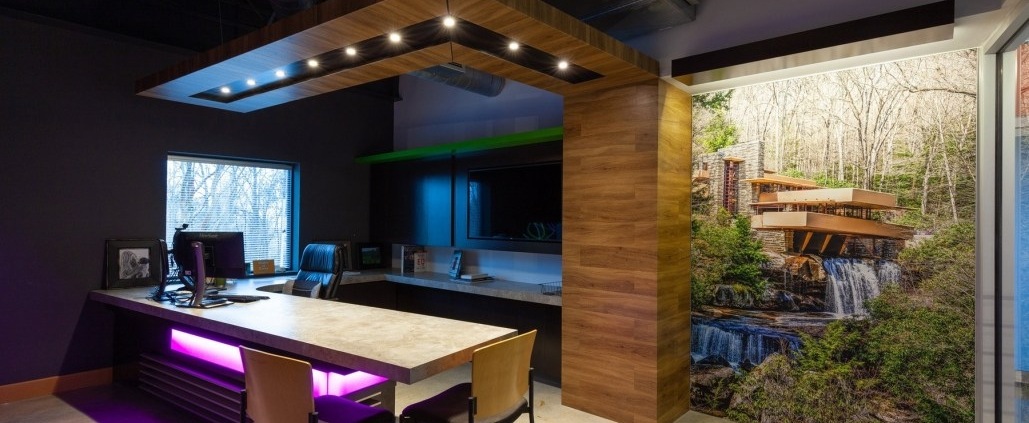What is sensorial marketing & why it works so well for commercial interior design
By Adam Huxhold, Method-1 Division Vice President
Adam Huxhold has worked in commercial interior design since 2001. He has focused on sensorial marketing for 14 of those years while also bringing the physical to life with architectural design.
When you think about your favorite brand or your favorite store to go into, what comes to mind? Chances are, something stands out. A smell, a sound, a moving image, or something you touched. These brands or businesses are using sensorial marketing to engage two or more of your senses and make your experience more impactful.
At Method-1, we know that engaging the senses is a powerful tool for design. We’ve been implementing multi-sensory solutions since 2007, and we officially launched our Sensorial Division in early 2019. We program sensorial solutions into the physical spaces that we design, fabricate, and implement through our streamlined commercial interior design process.
But why do we focus so much on sensory design, especially when not many other firms are doing it? The short answer is that our clients’ customers, members, patients, consumers, and other types of patrons are asking for it.
Why sensory design?
Sensory marketing has been around since the experience economy began in the late 1990s. Do you remember when you could buy a cup of coffee for just $.30? Then Starbucks came along, and now that same cup of coffee is $5. So sensory marketing is not new, but it is unique to a design firm like Method-1.
Our clients want more than what traditional design firms can offer when it comes to providing sensorial experiences. In fact, there was a global study conducted by Walnut Unlimited, a global market research agency specializing in neuroscience and behavioral psychology and economics, which found that “90% of consumers say they’re more likely to revisit a brick and mortar business if the music, visuals, and scent create an enjoyable atmosphere.” Moreover, 75% of consumers will stay longer, and 80% will recommend a business if it looks good, sounds good, and smells good.
Sensory marketing supplements “traditional marketing” by relating to the consumer on an emotional, cognitive, behavioral, and relational level. A multi-sensory experience occurs when the consumer is appealed by two or more senses. Appealing to a consumer’s senses in a positive way will generate a belief, feeling, thought, and opinion about the brand that will lead to a memorable connection.
How Method-1 creates sensory experiences
We know that the more senses that are influenced in a positive way, the more likely a brand will be remembered. We want to influence or control those senses to bring customers and clients into a physical location. Once they are there, the business owns their senses. Sensory design takes it from there.
Here’s how we can do it:
Sight
When it comes to the sense of sight, it’s all about digital signage technology. In place of traditional print advertisements, menus, posters, or signs, digital signage is video content or digital images displayed on a high-definition screen or a series of HD screens. You can think of it like digital wallpaper. We are visually attracting people to the space.
Sound
With sound, we focus primarily on music and messaging. We offer multiple, flexible music programming options to empower our clients to deliver a signature sound, or soundtrack, at any of their locations.
The sound of messaging is also important. Brands invest a lot to drive traffic through their door or make the phones ring, so why not capitalize on the opportunity to speak to them with on-hold or overhead messages? We write, produce, and execute laser-targeted messaging strategies to make the most of every call or dwelling shopper.
Scent
Scent is the strongest sense linked to memory and emotion. With our blue-tooth controlled diffusers, we can welcome guests with the inviting aroma of freshly baked cookies, attract shoppers with seasonal scents, soothe patients with a hint of lavender, or neutralize malodor with eucalyptus mint. Scent can play a subtle yet significant role in transforming perceptions and elevating the overall experience for maximum effect.
Touch
For touch, we use interactive touch displays, such as a tablet at a bank where customers can look at products and services, sign up for new online accounts, and more. We can even create touch interactive gamification options with large format displays you can walk up to and interact with.
Who can benefit from sensorial marketing?
With all of these sensory design options, every industry has the opportunity to appeal to two or more senses to capitalize on sensorial marketing. Whether it be healthcare, financial institutions, universities, retail, or restaurants, each one can influence their audience in unique and memorable ways.
Method-1 is unique in that we have a Sensorial Division with a team of designers who are familiar with appealing to all of these senses through design. If you want more from the interior design of your commercial space like so many of our clients, work with us to bring the physical to life in powerful ways.
Method-1 Interiors is a division of ExpoDisplays. We create branded commercial environments in all shapes and forms.
Method-1 is the only commercial interior firm with a simple, innovative process of creating impressive environments. We handle everything: consultation, design, construction, and installation. This unique approach produces inspiring interiors without the complicated processes found with conventional interior design and construction methods. Headquartered in Birmingham, Alabama, call 205-439-8234 for more information.


